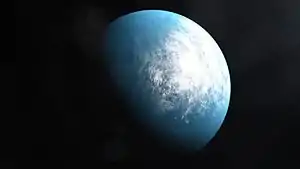 An artist's impression of TOI-700 d, depicted here as a possible ocean planet. The actual appearance of the planet is not currently known. | |
| Discovery[1] | |
|---|---|
| Discovered by | Emily Gilbert |
| Discovery date | 3 January 2020 |
| Transit | |
| Orbital characteristics[2] | |
| 0.1633±0.0027 AU | |
| Eccentricity | 0.042+0.045 −0.030 |
| 37.42396+0.00039 −0.00035 d | |
| Inclination | 89.80°+0.12° −0.10° |
| 10°+120° −140° | |
| Star | TOI-700 |
| Physical characteristics | |
Mean radius | 1.073+0.059 −0.054 R🜨[2] |
| Mass | ≙1.72+1.29 −0.63 MEarth[1] |
| Temperature | Teq: 268.8 K (−4.3 °C; 24.2 °F)[3] |
TOI-700 d is a near-Earth-sized exoplanet, likely rocky, orbiting within the habitable zone of the red dwarf TOI-700, the outermost planet within the system. It is located roughly 101.4 light-years (31.1 pc) away from Earth in the constellation of Dorado. The exoplanet is the first Earth-sized exoplanet in the habitable zone discovered by the Transiting Exoplanet Survey Satellite (TESS).[4][5][6]
TOI-700 d orbits its star at a distance of 0.163 AU (24,400,000 km; 15,200,000 mi) from its host star with an orbital period of roughly 37.4 days and has a radius of around 1.19 times that of Earth. It has been estimated that the planet receives about 86% the energy that the Earth receives from the Sun.[7]
It was discovered in early January 2020 by the Transiting Exoplanet Survey Satellite (TESS).
Physical characteristics
Mass, radius and temperature
TOI-700 d is Earth-sized, an exoplanet that has a radius and mass similar to the Earth. It has a radius of about 1.07 R🜨; its mass has not been measured, but is predicted to be around 1.72 MEarth.[1] If it has an Earth-like atmosphere, then its average temperature would be about 268.8 K (−4.3 °C; 24.2 °F).[3] A small chance of a runaway greenhouse effect exists.[8]
Host star
TOI-700 is a red dwarf of spectral class M that is about 40% the mass and radius, and very roughly 50% of the temperature of the Sun.[6] The star is bright with low levels of stellar activity. Over the 11 sectors observed with TESS, the star does not show a single white-light flare. The low rotation rate is also an indicator of low stellar activity.[1]
Orbit
TOI-700 d orbits its host star with an orbital period of 37.42 days. It has an orbital radius of about 0.163 AU (24.4 million km; 15.2 million mi), less than half of that of Mercury to the Sun in the Solar System. It receives about 86% of Earth's sunlight from its host star.
Habitability

TOI-700 d orbits in the habitable zone of its host star. The solar wind ram pressure and intensity of the interplanetary magnetic field are expected to be similar to the Earth's, therefore retention of the planetary atmosphere is likely.[9][10]
History and discovery
TOI-700 d was discovered by a team of astronomers led by Emily Gilbert using the Transiting Exoplanet Survey Satellite (TESS) in early January 2020. This was the first Earth-sized exoplanet in the habitable zone discovered by TESS.[11]
See also
References
- 1 2 3 4 Gilbert, Emily A.; Barclay, Thomas; Schlieder, Joshua E.; Quintana, Elisa V.; Hord, Benjamin J.; Kostov, Veselin B.; Lopez, Eric D.; Rowe, Jason F.; Hoffman, Kelsey; Walkowicz, Lucianne M.; Silverstein, Michele L. (3 January 2020). "The First Habitable Zone Earth-sized Planet from TESS. I: Validation of the TOI-700 System". The Astronomical Journal. 160 (3): 116. arXiv:2001.00952. Bibcode:2020AJ....160..116G. doi:10.3847/1538-3881/aba4b2. S2CID 209862554.
- 1 2 Gilbert, Emily A.; Vanderburg, Andrew; et al. (January 2023). "A Second Earth-Sized Planet in the Habitable Zone of the M Dwarf, TOI-700". The Astrophysical Journal Letters. 944 (2): L35. arXiv:2301.03617. Bibcode:2023ApJ...944L..35G. doi:10.3847/2041-8213/acb599. S2CID 255570018.
- 1 2 Rodriguez, Joseph E.; Vanderburg, Andrew; Zieba, Sebastian; Kreidberg, Laura; Morley, Caroline V.; Kane, Stephen R.; Spencer, Alton; Quinn, Samuel N.; Eastman, Jason D.; Cloutier, Ryan; Huang, Chelsea X. (3 January 2020). "The First Habitable Zone Earth-Sized Planet from TESS. II: Spitzer Confirms TOI-700 d". The Astronomical Journal. 160 (3): 117. arXiv:2001.00954. Bibcode:2020AJ....160..117R. doi:10.3847/1538-3881/aba4b3. S2CID 209862553.
- ↑ Andreolo, Claire; Cofield, Calla; Kazmierczak, Jeanette (6 January 2020). "NASA Planet Hunter Finds Earth-Size Habitable-Zone World". NASA. Retrieved 6 January 2020.
- ↑ Garner, Rob (6 January 2020). "NASA Planet Hunter Finds Earth-Size Habitable-Zone World". NASA. Retrieved 6 January 2020.
- 1 2 Wall, Mike (6 January 2020). "NASA's TESS Planet Hunter Finds Its 1st Earth-Size World in 'Habitable Zone'". Space.com. Retrieved 6 January 2020.
- ↑ "[VIDEO] TOI 700d : une planète de la taille de la Terre découverte dans une "zone habitable"". midilibre.fr (in French). Retrieved 17 April 2020.
- ↑ Suissa, Gabrielle; Wolf, Eric T.; Kopparapu, Ravi Kumar; Villanueva, Geronimo L.; Fauchez, Thomas; Mandell, Avi M.; Arney, Giada; Gilbert, Emily A.; Schlieder, Joshua E.; Barclay, Thomas; Quintana, Elisa V.; Lopez, Eric; Rodriguez, Joseph E.; Vandenburg, Andrew (1 July 2020). "The First Habitable Zone Earth-sized Planet from TESS. III: Climate States and Characterization Prospects for TOI-700 d". The Astronomical Journal. 160 (3): 118. arXiv:2001.00955. Bibcode:2020AJ....160..118S. doi:10.3847/1538-3881/aba4b4. S2CID 209862275.
- ↑ Cohen, O.; Garraffo, C.; Moschou, S.; Drake, J.; Alvarado-Gomez, J.; Glocer, A.; Fraschetti, F. (2020). "The Space Environment and Atmospheric Joule Heating of the Habitable Zone Exoplanet TOI 700 D". The Astrophysical Journal. 897 (1): 101. arXiv:2005.11587. Bibcode:2020ApJ...897..101C. doi:10.3847/1538-4357/ab9637. S2CID 218869952.
- ↑ Dong, Chuanfei; Jin, Meng; Lingam, Manasvi (2020). "Atmospheric Escape from TOI-700 d: Venus versus Earth Analogs". The Astrophysical Journal. 896 (2): L24. arXiv:2005.13190. Bibcode:2020ApJ...896L..24D. doi:10.3847/2041-8213/ab982f. S2CID 219558481.
- ↑ "NASA's TESS Planet Hunter Finds Its 1st Earth-Size World in 'Habitable Zone'". Space.com. 7 January 2020.
External links
- TESS – Official WebSite
- NASA Exoplanet Archive System Overview page for TOI-700 d
- ExoFOP TIC 150428135 TOI-700 in the Exoplanet Follow-up Observing Program website



_on_Jul_14_2020_aligned_to_stars.jpg.webp)